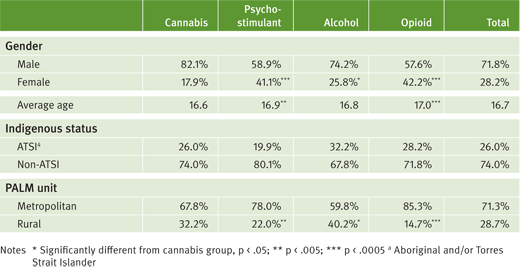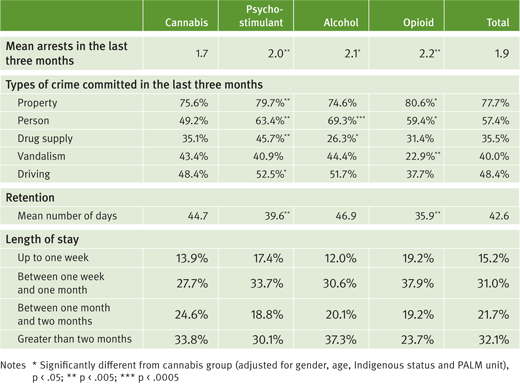Bulletin 1
Clinical profiles of cannabis-dependent adolescents in residential substance use treatment
Published January 2008
Anthony Arcuri, Jan Copeland and John Howard
Key points
- Young people are most likely to present to residential substance use treatment in Australia with cannabis as their principal drug of concern
- Those who present with cannabis use problems are younger and more likely to be male
- They are also more likely to seek treatment in rural settings than are their primarily psychostimulant or opioid-using peers
- The mental health of young people presenting with cannabis problems is as poor as that of primary psychostimulant users, and poorer than that of primary alcohol or opioid users
- Cannabis-using young people presenting to residential treatment are less criminally involved
- Young people with cannabis as a principal drug of concern were retained longer than other groups
Background
Cannabis is the most common drug for which young people present to specialist drug and alcohol treatment in Australia. In 2005-06, 50.1% of Australian substance use treatment episodes among young people aged 10 to 19 years involved cannabis as the principal drug of concern, followed by alcohol (23.4%), psychostimulants (i.e., meth/amphetamines, ecstasy and cocaine; 10.5%) and opioids (5.9%).1
Cannabis use among young people has been associated with impairments in a number of areas of functioning, including mental health (most notably psychosis, but also depression and anxiety), physical health, vocational and educational engagement, social and family functioning, and delinquent and criminal behaviour.2,3 It is unclear, however, whether these impairments among young cannabis users are more or less pronounced than they are among young people who primarily use alcohol, psychostimulants or opioids in similarly problematic ways, and how existing psychopathology or other vulnerability may be exacerbated by cannabis use.
Gaining such an understanding may assist substance use treatment program developers, managers and clinicians to meet the specific needs of young cannabis users presenting to treatment. This knowledge may be particularly useful within residential treatment settings where some needs of cannabis users may be overlooked when attention is focussed on the management of more visible and immediate symptoms and behaviours associated with substances other than cannabis (such as the aggressive behaviours purportedly associated with psychostimulant and alcohol presentations).4 More in-depth knowledge of the clinical profile of young cannabis users may also assist funding bodies to understand the need for residential treatment services for these young people, when it is often perceived that young cannabis users should not require intensive, residential treatment services.
The purpose of this inaugural NCPIC Bulletin is, therefore, to compare aspects of the functioning of young people presenting to residential substance use treatment with cannabis as their primary substance of concern with those presenting with alcohol, a psychostimulant, or an opioid as their substance of principal concern.
The residential treatment program
The Ted Noffs Foundation's Program for Adolescent Life Management (PALM) offers up to three months of residential treatment, followed by up to twelve months of continuing care, for substance dependent young people aged between 14 and 18 years. PALM is based on a harm reduction philosophy and relapse prevention planning, and provides 42 beds across two metropolitan (Sydney and the ACT) and two rural (Coffs Harbour and Dubbo) locations in eastern Australia. Practically, PALM offers its residents a structured program incorporating: living skills training, therapeutic, vocational/educational and creative group work; individual counselling; family work; journaling; and recreational activities.
The young people
The participant sample initially consisted of all 1254 admissions to PALM between January 2001 and June 2007. Nine of these admissions were excluded from the sample due to missing data. Among the remaining sample of 1245 admissions, cannabis was the most common substance of principal concern (553, or 44.4% of, admissions), followed by psychostimulants (282, 22.7%), alcohol (209, 16.8%), and opioids (177, 14.2%). Psychostimulant presentations incorporated those relating primarily to meth/amphetamines (244, 19.6%), ecstasy (21, 1.7%), or cocaine (17, 1.4%). The remaining admissions, which involved either an inhalant (19, 1.5%) or a tranquilliser (5, 0.4%) as the substance of principal concern, were removed from the sample as their small numbers suggested that they were not amenable to meaningful comparisons with admissions that involved cannabis as the main drug of concern. As a result, the final sample consisted of 1221 admissions.
For all young people in the sample, primary substances of concern were assessed as substances of dependence according to the associated DSM-IV criteria. Therefore, all of the primarily cannabis-using young people in this study were cannabis dependent. Also, it is noted that some admissions with cannabis as the primary substance of concern also had a psychostimulant, alcohol, and/or an opioid as a secondary substance of concern (40.5%, 49.3%, and 5.1%, respectively). Similarly, some admissions with a psychostimulant, alcohol, or an opioid as the substance of principal concern also had cannabis as a substance of secondary concern (69%, 64.2%, and 48.9%, respectively).
Nature of the comparisons
The group of admissions with cannabis as the primary substance of concern was compared statistically with each of the psychostimulant, alcohol and opioid groups on the following domains: demographic characteristics, physical and mental health, criminal behaviour, and retention in treatment. Comparisons involving either pre-treatment functioning/experiences or retention were adjusted for potential differences associated with gender, age, Indigenous status, and/or the location of the PALM unit admitted to (i.e., either metropolitan or rural; the great majority of, but not all, admissions were to units in the young people's general areas of residence). Most of the data were collected immediately prior to each admission via the Ted Noffs Foundation Youth Substance Use Assessment Part A/B (TNFYSUAA/B),5 a self-report instrument that incorporates both original items and existing assessment tools, including the Brief Symptom Inventory (BSI),6 the Brief Treatment Outcome Measure (BTOM),7 and adapted portions of the Opiate Treatment Index (OTI).8 Retention was measured immediately following treatment as the number of days at PALM.
Results
Demographics
As demonstrated in Table 1, the cannabis group was: more likely than the other groups to be male; younger and more likely to have been admitted to a rural PALM unit than were the psychostimulant and opioid groups; and more likely than the alcohol group to have been admitted to a metropolitan PALM unit.
Table 1
Demographics of cannabis group vs. psychostimulant, alcohol and opioid groups

| Cannabis |
Phsycho- stimulant |
Alcohol | Opioid | Total | |
| Gender | |||||
| Male | 82.1% | 58.9% | 74.2% | 57.6% | 71.8% |
| Female | 17.9% | 41.1% | 25.8% | 42.2% | 28.2% |
| Average age | 16.6 | 16.9 | 16.8 | 17.0 | 16.7 |
| Indigenous status | |||||
| ATSI | 26.0% | 19.9% | 32.2% | 28.2% | 26.0% |
| Non-ATSI | 74.0% | 80.1% | 67.8% | 71.8% | 74.0% |
| PALM unit | |||||
| Metropolitan | 67.8% | 78.0% | 59.8% | 85.3% | 71.3% |
| Rural | 67.8% | 22.0% | 40.2% | 14.7% | 28.7% |
Physical and mental health
Table 2 reveals that, after adjusting for gender, age, Indigenous status, and PALM unit, the cannabis group demonstrated: better general, musculo-skeletal, neurological and gastrointestinal health than did the psychostimulant group; poorer general, genito-urinary and musculoskeletal health than did the alcohol group; and poorer cardio-respiratory but better gastrointestinal health than did the opioid group.
In relation to mental health, the cannabis group demonstrated: more obsessive-compulsive and general psychiatric symptoms, and more symptoms of interpersonal sensitivity, depression, phobic anxiety, paranoia, and psychoticism, than did the alcohol and opioid groups; and more symptoms of anxiety and hostility than did the opioid group. In addition, the cannabis group was more likely than the opioid group ever to have self-harmed and currently to take psychiatric medication, and more likely than the alcohol and opioid groups to have had thoughts of ending their lives in the last three months.
Table 2
Physical and mental health of cannabis group vs. psychostimulant, alcohol and opioid groups

| Cannabis |
Psycho- stimulant |
Alcohol | Opioid | Total | |
| Physical health | |||||
| General | 6.2 | 7.7 | 5.8 | 6.9 | 6.6 |
| Cardio-respiratory | 4.2 | 4.7 | 3.9 | 3.8 | 4.2 |
| Genito-urinary | 0.4 | 0.6 | 0.3 | 0.5 | 0.4 |
| Musculo-skeletal | 1.2 | 1.4 | 0.9 | 1.4 | 1.2 |
| Neurological | 3.5 | 4.5 | 3.7 | 3.7 | 3.8 |
| Gastro-intestinal | 1.6 | 2.2 | 2.6 | 2.6 | 1.9 |
| Mental Health | |||||
| Somatization | 0.86 | 1.17 | 0.89 | 0.89 | 0.92 |
| Obsessive-Compulsive | 1.60 | 1.82 | 1.40 | 1.40 | 1.59 |
| Interpersonal Sensitivity | 1.10 | 1.31 | 0.92 | 0.92 | 1.10 |
| Depression | 1.28 | 1.52 | 1.21 | 1.21 | 1.31 |
| Anxiety | 1.04 | 1.29 | 0.95 | 0.95 | 1.07 |
| Hostility | 1.45 | 1.59 | 1.35 | 1.26 | 1.44 |
| Phobic Anxiety | 0.69 | 0.82 | 0.60 | 0.60 | 0.69 |
| Paranoia | 1.24 | 1.48 | 1.06 | 1.17 | 1.25 |
| Psychoticism | 1.08 | 1.23 | 0.95 | 0.88 | 1.07 |
| Global Severity | 1.17 | 1.38 | 1.06 | 1.06 | 1.18 |
| Self-harm and suicide | |||||
| Ever self-harmed | 37.5% | 46.8% | 44.1% | 32.0% | 40.2% |
| Thoughts of ending life in past three months | 43.1% | 49.1% | 32.6% | 32.6% | 42.1% |
| Ever attempted suicide | 36.3% | 48.6 | 37.9% | 37.9% | 39.7% |
| Ever seen a mental health professional | 74.4% | 76.9% | 78.9% | 74.3% | 75.7% |
Criminal behaviour and retention
Table 3 reveals that the cannabis group was, on average, arrested less often in the last three months than were the other groups. In addition, the cannabis group was: less likely than the psychostimulant group to have engaged in property, person, drug supply and driving crimes in the last three months; less likely to have engaged in person crime, but more likely to have engaged in drug supply crime, in the last three months than was the alcohol group; and less likely to have engaged in property and person crimes, but more likely to have engaged in vandalism crime, in the last three months than was the opioid group. Finally, the cannabis group stayed in treatment for a greater mean number of days than did the psychostimulant and opioid groups.
Table 3
Criminal behaviour and retention of cannabis group vs. psychostimulant, alcohol and opioid groups

| Cannabis |
Psycho- stimulant |
Alcohol | Opioid | Total | ||
| Mean arrests in the last three months | 1.7 | 2.0 | 2.1 | 2.2 | 1.9 | |
| Types of crime committed in the three months | ||||||
| Property | 75.6% | 79.7% | 74.6% | 80.6% | 77.7% | |
| Person | 49.2% | 63.4% | 69.3% | 59.4% | 57.4% | |
| Drug supply | 35.1% | 45.7% | 26.3% | 31.4% | 35.5% | |
| Vandalism | 43.4% | 40.9% | 44.4% | 22.9% | 40.0% | |
| Driving | 48.4% | 52.5% | 51.7% | 37.7% | 48.4% | |
| Retention | ||||||
| Mean number of days | 44.7 | 39.6 | 46.9 | 35.9 | 42.6 | |
| Length of stay | ||||||
| Up to one week | 13.9% | 17.4% | 12.0% | 19.2% | 15.2% | |
| Between one week and one month | 27.7% | 33.7% | 30.6% | 37.9% | 31.0% | |
| Between one month and two months | 24.6% | 18.8% | 20.1% | 19.2% | 21.7% | |
| Greater than two months | 33.8% | 30.1% | 37.3% | 23.7% | 32.1% |
Summary and conclusions
These findings suggest that, compared with young people who present to treatment primarily with opioid use, those who present primarily with cannabis use have greatly elevated symptoms of mental distress, including depression, anxiety, hostility, paranoia, psychoticism, self-harm, and suicidal ideation.
In addition, the results indicate that, relative to young people who present to treatment primarily with alcohol use, those who present primarily with cannabis use demonstrate poorer physical and mental health, including depression, paranoia, psychoticism and suicidal ideation. These findings further suggest that, compared with young people who present to residential substance use treatment primarily with psychostimulant use, those who present primarily with cannabis use have fewer symptoms of physical ill health but do not differ on several indices of mental distress.
In contrast, it appears that they are arrested less often and are less likely to have self-reported recently being engaged in crimes against persons and property. They also are better retained in treatment than are those presenting with opioid, psychostimulant or alcohol related problems.
Given that primary cannabis users appear to stay in treatment for longer than do their primarily psychostimulant- or opioid-using peers (which may also reflect their engagement in fewer challenging behaviours that lead to early disciplinary discharge), there may exist additional opportunities for treatment services to meet their needs more appropriately. It should be acknowledged, however, that primary cannabis users may too exhibit challenging behaviours - possibly reflective of their heightened hostile, paranoid and psychotic feelings – that warrant additional support.
The findings of this study of over 1200 young people in residential treatment at PALM programs support the need for the provision of residential services for young cannabis users who are dependent, present with complex needs, and may be polysubstance users. The primary cannabis users in this study exhibited significant mental health problems, more severe on average than those presenting with opioid or alcohol problems, at a significantly younger age. Despite this, they were attracted and retained in an intensive treatment program, with a longer average length of stay than young people presenting with primary opioid, alcohol or psychostimulant concerns. While this study did not explore treatment outcome, retention in treatment is positively correlated with improved treatment outcome.9
This study highlights the complex needs of young cannabis users presenting for residential treatment and the need for staff to be skilled in the management of comorbid substance use and mental health disorders, but that, despite this, young cannabis users are well retained in treatment.
References
- Australian Institute of Health and Welfare, Alcohol and other drug treatment services in Australia 2005-06: Report on the National Minimum Data Set. 2007, (Drug Treatment Series Number 7). Canberra: Australian Institute of Health and Welfare (AIHW cat. no. HSE 53).
- Copeland, J., S. Gerber, and W. Swift, Evidence-based answers to cannabis questions: a review of the literature. 2006, (ANCD Research Paper 11). Canberra: Australian National Council on Drugs.
- McLaren, J. and R.P. Mattick, Cannabis use in Australia: Use, supply, harms, and responses. 2007, (Monograph Series No. 57). Sydney: National Drug and Alcohol Research Centre.
- Boles, S.M. and K. Miotto, Substance and violence: A review of the literature. Aggression and Violent Behavior, 2003. 8(2): p. 155-174.
- Howard, J., A. Arcuri, and M. Gascoigne, Ted Noffs Foundation Youth Substance Use Assessment Part A/B. 2001-2007, Sydney: Ted Noffs Foundation.
- Derogatis, L.R. BSI Brief Symptom Inventory: Administration, scoring, and procedures manual. 1992, Minneapolis: National Computer Systems, Inc.
- Lawrinson, P., et al., The Brief Treatment Outcome Measure: Detoxification, rehabilitation & counselling (BTOM) manual. 2003, Sydney: National Drug and Alcohol Research Centre.
- Darke, S., et al., The Opiate Treatment Index (OTI) Researcher's Manual. 1991, National Drug and Alcohol Research Centre Technical Report Number 11. Sydney: National Drug and Alcohol Research Centre.
- Hser, Y-I, Evans, E., Huang, D. and Anglin, D.A. (2004). Relationship between drug treatment services, retention, and outcomes. Psychiatric Services 55, 767-774.
We thank TNF, a NCPIC consortium partner, for generously sharing their client data.













































